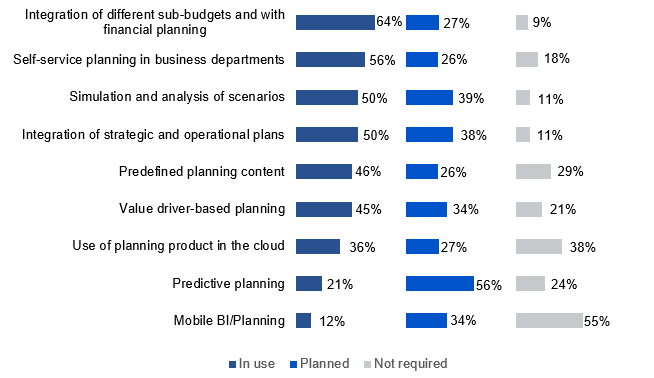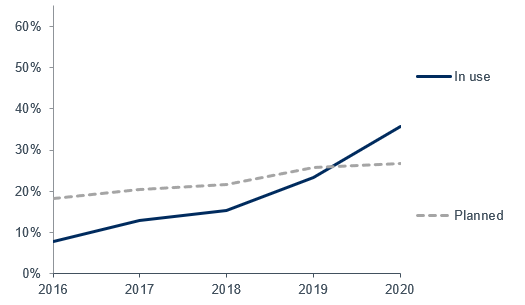
The Planning Survey 20 – Integrated corporate planning, predictive planning & forecasting and cloud are the main trending topics
The Planning Survey 20 – recently undertaken by BARC – shows that the integration of corporate planning, predictive planning and forecasting, and the use of the cloud are currently the most important trending topics for companies in the field of planning (see Figure 1).

Figure 1: Which of the following does your company do/use with your product for planning and budgeting? (n=893)
Integrated corporate planning
Integrated corporate management requires fast and well-founded decisions. Increasing dynamics and growing time pressure are forcing organizations to update their targets and forecasts at ever shorter intervals. Many companies have therefore consistently integrated their planning. However, many still have not (see Figure 1). The comprehensive integration of planning and the integration of planning with analytics are essential to holistic corporate management and the use of modern planning approaches (e.g., predictive planning and forecasting). In order to develop its full benefits, the integration of planning must therefore be carried out carefully at various levels:
- Integration of strategy management and annual budgeting
- Integration of annual planning and forecasting
- Integration of operational planning and financial planning
In addition to the integration of corporate planning, its integration with analytics (e.g., reporting, analysis, dashboards) and other performance management processes (e.g., consolidation, risk management) is a vital prerequisite for holistic corporate management. The optimal management of organizations requires a seamless integration of analytics and planning functionality. Only this integration will allow the comprehensive and efficient verification of the achievement of objectives. It also enables the successful application of statistical methods and machine learning in planning and forecasting (predictive planning and forecasting).
Predictive planning and forecasting
Predictive planning and forecasting is rapidly gaining relevance for many companies and has been a stable trend for years. Two out of three organizations rate the approach as very important or important for future corporate planning. And those that do are much more likely to report greater benefits from their planning activities.
77 percent of the companies surveyed are either already using predictive planning and forecasting or plan to invest in it in the future (see Figure 1). The goal is to generate meaningful, high-quality planning figures with little effort and a fast turnaround time – a major challenge in corporate planning today. This applies to classic annual planning and budgeting, but increasingly also to short-term prognosis and forecasting processes. Many companies are therefore striving for solutions to reduce costs and speed up processes so they are turning to modern planning approaches such as predictive planning and forecasting (i.e., the use of statistical methods and machine learning). The integration of planning – and of planning with analytics – have to be in place for this to work and are therefore the backbone of the approach.
The still low level of use of predictive planning and forecasting in practice (21 percent) is in stark contrast to the assessment of the relevance and potential of the approach. The development of expertise in this area and the provision of the necessary financial and human resources are major challenges but also obstacles to its use. However, many companies are planning to improve their know-how and skills. The approaches and use cases for predictive planning and forecasting in organizations are diverse and range from suggesting values for planners to validating manual plan data entries and identifying driver dependencies.
Cloud
The use of the cloud for the deployment of planning tools is becoming increasingly important. The proportion of organizations that plan to use a planning solution in the cloud in the future has increased only slightly over time. However, the number of companies actually using a cloud-based solution has increased massively (see Figure 2). In 2016, the proportion was still below 10 percent but it has surged to 36 percent in 2020. Using the cloud is particularly attractive when addressing new requirements or implementing new planning tools or use cases. The main reasons for using the cloud are greater flexibility and elasticity (59 percent), reduced maintenance requirements for hardware and software (40 percent) and costs (29 percent).

Figure 2: Time series of the use of planning products in the cloud, 2016-2020, (n=various)
Conclusion
The integration of corporate planning, predictive planning and forecasting, and the use of the cloud are currently the most important planning trends out there. Companies should take the time to evaluate each of them. The most successful companies (in terms of the benefits they derive from their planning) are currently investing massively in these areas. Uniform software platforms such as Unit4 FP&A should form the basis for technical and business integration, which is a decisive factor for sustainable success. The use of market-proven and leading technologies not only secures investments, but also invariably ensures that extensive technological consulting expertise is more readily available.


